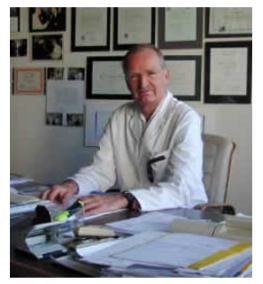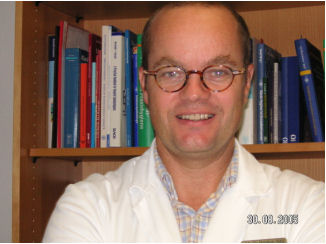[Desinfektion als Infektionsprävention im Wandel der Zeit]
M. Hell 1G. Pauser 2
1 Hospital Hygiene, SALK, Paracelsus Private Medical University, Salzburg, Austria
2 University Hospital for Anesthesiology, Perioperative Medicine and General Intensive Medicine at the St. Johanns-Spital, SALK, PMU, Salzburg, Austria
Zusammenfassung
Die Anwendung alkoholischer Lösungen im Bereich der Hygienischen und Chirurgischen Händedesinfektion hat sich in den letzten Jahren und Jahrzehnten immer mehr durchgesetzt. Das herkömmliche Händewaschen mit Wasser und Seife wurde im klinischen Alltag praktisch völlig ersetzt, ebenso wie der Einsatz desinfizierender Seifenlösungen als chirurgische Händedesinfektion. Die Anwendungszeit der alkoholischen Händedesinfektion im OP konnte in den letzten Jahren von 5 auf 3 Minuten reduziert werden, weitere Entwicklungen stehen bereits an. Die zunehmende Sensibilisierung in Bezug auf die Verträglichkeit hat auch hier bereits erfreuliche Lösungen gebracht. Dramatisch auch der Wandel bei der präoperativen Hautdesinfektion: Die nur langsam wirkenden nicht-alkoholischen Lösungen (z. B. Jodophore) sind durch alkoholische Lösungen mit sicherer Wirkung nahezu vollständig ersetzt. Die Schleimhautdesinfektion blieb eine Domäne der nicht-alkoholischen Lösungen. Hier deutet sich eine Ablöse der jodhaltigen Produkte an.
Der Begriff der 'Instrumentendesinfektion' ist durch den Begriff der „Aufbereitung“ bzw. der Medizinprodukteaufbereitung ersetzt worden und beschreibt damit den (auch von der Gesetzgebung unterstützten) Trend zur apparativen, thermischen Desinfektion. Die exakte Reinigung wurde damit die unabdingbare Voraussetzung für die meist an die Desinfektion anschließende Sterilisation.
Die größte Uneinigkeit innereuropäisch herrscht in Bezug auf die Flächendesinfektion. Die routinemäßige, parallele Reinigung und Desinfektion sämtlicher patientennahen und patientenfernen Flächen wird zunehmend abgelöst von der gezielten, Anlass bezogenen Desinfektion patientennaher Flächen. Problem dabei ist, dass das medizinische Personal aus der Tradition heraus nach wie vor Reinigung und Desinfektion gleichsetzt. Dazu kommt, dass es unter den aktuellen ökonomischen Vorgaben des Spitalsbetriebs immer schwieriger wird, einen ausreichenden Reinigungs- und Desinfektionserfolg sicherzustellen. Reinigung und Desinfektion der Flächen müssen insbesondere in Anlasssituationen auch außerhalb der Regeldienstzeit für einen hygienesicheren Betrieb gewährleistet sein.
Die zentrale Herausforderung der Zukunft bleibt die Desinfektion bzw. Aufbereitung hoch entwickelter medizinischer Instrumente mit speziellen Anforderungen (thermolabile Güter mit kompliziertem Aufbau und dadurch schwer zugänglichen Oberflächen, z. B. flexible Endoskope). Hier gilt es noch viel Arbeit zu leisten für eine tatsächliche Patienten-Hygienesicherheit.
Text
The paper takes a look at the current role of hand and skin disinfection as well as of surface and instrument disinfection in our institution in the context of hospital infection control.
Hand disinfection
In recent years and decades increasingly more emphasis has been placed on alcohol-based solutions for hygienic and surgical hand disinfection. Traditional handwashing with soap and water has been largely supplanted in the everyday clinical setting by the use of alcohol-based hand disinfection. The use of soap-based solutions for surgical hand disinfection is now virtually obsolete and has been replaced by a combination of washing with a non-disinfectant soapy solution, followed by alcohol-based hand disinfection. Thanks to an enhanced application technique as well as to better knowledge of its mechanism of action, it has been possible in recent years to reduce the exposure time for alcohol-based hand disinfection in surgery from 5 to 3 minutes. Even halving this application time to 1.5 minutes is being currently debated. For practical reasons, we take a very critical view of this proposal at the moment (compliance!).
Furthermore, at an age where there is growing awareness among medical personnel of the tolerability profiles of chemical products, manufacturers and infection control teams are called upon to develop and use skin and hand disinfectants that will find acceptance among users.
See: [1], [2]; ÖNORM EN 1500; Einwirkzeiten nach ÖGHMP und DGHM.
Skin/mucosa disinfection
The most dramatic change seen here over the past twenty years has been in preoperative skin disinfection. In this domain, because of their longer onset of action and their limited spectrum of efficacy, the non-alcohol-based solutions (e.g. iodophors) have been virtually replaced by alcohol-based solutions.
Conversely, non-alcohol-based solutions, especially the iodophors which have been used here without any reservations for decades, continue to be used for disinfection of mucous membranes. In the form of octenidine, an iodine-free product has also been used here with comparable efficacy in recent years.
See: [3].
Instrument Disinfection
The term “instrument disinfection” has been largely supplanted now by the expression “instrument reprocessing or medical device decontamination”. On the one hand, the new nomenclature reflects the current role of instrument processing while, on the other hand, it takes account of the trend towards thermal disinfection and the sharp decline in chemical disinfection. Today, both processes are by all means being implemented in the form of automated decontamination / reprocessing (using washer-disinfectors). In recent years meticulous cleaning has also been identified as an indispensable precondition for the sterilization processes, which normally follow disinfection. The problems associated with prions have been responsible for taking a closer look at the cleaning-step component in instrument decontamination.
These insights have also given rise to the formulation of pertinent standards (e.g. the Austrian standard ÖNORM EN ISO 15883), to which the Medical Devices Act (MPG) makes reference.
See: MPG; ÖNORM EN ISO 15883; Richtlinie des RKI: Aufbereitung von Medizinprodukten; Richtlinien von ÖGSV und DGSV.
Surface Disinfection
The greatest lack of consensus at European level regarding the scope of the measures needed relates to surface disinfection. While throughout the entire last century, reflecting the drive towards maintenance of asepsis outside the surgical department, the customary practice in German-speaking countries was to disinfect regularly all surfaces close to and remote from the patient in the firm belief of thus being able to eliminate all potential inanimate microbial sources, today there is widespread consensus that these non-selective measures should be replaced by selective disinfection of surfaces close to the patient, bearing in mind the prevailing situation. The only points of the debate to be still resolved are the scope and frequency of such measures.
Today, we find ourselves confronted with two problems. As a relic dating back to the tradition of using a disinfectant to clean all surfaces, disinfection and cleaning are often viewed by medical personnel as equivalent tasks, with no distinction being made between the different objectives of the two tasks. There is need for enlightenment here, whereby cleaning and disinfection are clarified as two separate functions. This problem is further compounded by a second reality, i.e. in view of their current economic hardships the hospitals are finding it increasingly more difficult to assure adequately the success of cleaning, and in some cases also of disinfection, measures.
Here of course the main focus must be on the microbial transmission pathways which are largely known, however, this should not mean that cleaning as an overall maintenance strategy is neglected. To ensure effective infection control, cleaning and disinfection of surfaces in special situations must also be assured whenever warranted outside the regular working hours. This calls for selective investment of the available resources to assure patient safety.
Disinfection and decontamination of highly complex medical devices with special needs (heat-sensitive devices with an intricate design and, correspondingly, with surfaces that are difficult to access, e.g. flexible endoscopes) will present the main challenge in the future. There is still much to be accomplished here to assure the hygienic safety of the patient.
See: [4].
Curriculum Vitae
Hofrat Primarius Prof. Dr. med. habil Gernot Pauser
Figure 1 [Fig. 1]
Specialist for Anaesthetics, Specialist General Medicine, Emergency Physician.
Medical Director of the State Hospitals Salzburg.
Chairman of the Department of Anaesthetics and Intensive Therapy of the State Hospitals Salzburg.
Medical Scientific Head of the General Nursing Care School at the State Hospital of Salzburg.
Gernot Pauser studied Medicine at the University of Vienna where he got his degree in 1968. In 1970 he started working for the Clinic for Anaesthetics and General Intensive Care Medicine at the University of Vienna. 1971 he became General Practitioner, in 1974 Specialist for Anaesthetics and Intensive Care Medicine, Assistant Medical Director of the clinic and habilitated in this very subject in 1980. He was appointed as Head of the Department for Anaesthetics and Intensive Care Medicine for the State Hospitals of Salzburg and as „Associate Professor“ in 1987 and he finally becomes Medical Director of the State Hospitals Salzburg in 1998.
Court Counselor Professor Dr. Pauser has acquired an unusual amount of additional qualification during his scientific career, as e.g. the diploma for acupuncture. His interests range considerably wide: already 1979 he became the founder- and board- member of the Interdisciplinary Centre for Research and Development in the field of Intensive Medicine, Hernstein.
He is member of numerous national and international scientific bodies.
OA Dr. med. Markus Hell
Figure 2 [Fig. 2]
Specialist for Hygiene and Microbiology, Director for Hospital Hygiene of the Federal Clinics of Salzburg, Paracelsus Medical Private University Salzburg (PMU).
Dr. M. Hell obtained his doctorate at the Medical Faculty of the Innsbruck University in 1991. First taking on a job at the Federal Neuropathic Hospital Salzburg in 1995 he finally reached his true objective: the hospital hygiene. 1999 he became specialist for hygiene and microbiology, he is head of Hospital Hygiene for the Federal Clinics of Salzburg since 2000.
His special fields of interest are in the resistance epidemiology, registration of critical germs, as well as critical germs patient management respectively the antibiotic therapies and –strategies based on this, thus the issue of our times per se.
He also works in the area of surgical interdisciplinary intensive care medicine, takes care of several public health care institutions in Salzburg, reviews plans of hospitals to be built or re-constructed especially regarding the complex of Legionella.
References
[1] RKI. Händehygiene. Bundesgesundheitsblatt. 2000;43:230-3[2] Rotter ML. Arguments for alcoholic hand disinfection. J Hosp Inf. 2001;48 Suppl A:4-8.
[3] Koller W. Neue Empfehlungen für Desinfektionsmittel und Antiseptika. Medical Tribune 24; Inter medical report 3. ÖGHMP-Expertisenverzeichnis 2001.
[4] RKI. Anforderung an die Hygiene bei der Reinigung und Desinfektion von Flächen. Hyg Med. 2004;29:68-79. Bundesgesundheitsblatt. 2004;47:51-61.






